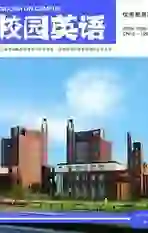A Book Report on Method in Translation History
2014-07-19曹丹
曹丹
【Abstract】This paper is a book report of Method in Translation History, a book on the field of translation history written by Anthony Pym, a professor of University of Barcelona. The author tries to give a general summary of the book content.
【Key Words】book report, method, translation history
1.Introduction
The book Method in Translation History, written by Anthony Pym, a professor of University of Barcelona, describes the research methods in the study of translation history. It was published by St. Jerome Publisher in Manchester, UK, 1998. The book includes twelve chapters. The first six chapters mainly expounds some important concepts and specific methods in the study of research methods in translation history and the later six chapters focuses on constructing the authors own theoretical framework.
2.Content Summary
There are twelve chapters in the book. The first half deals with practical aspects on how to do the translation history. To be specific, the first chapter “History” talks about some basic questions related to translation history like what is the essence of it, parts or studying fields involved in the research and the reasons why we study it. How to properly choose a topic among many possible questions which can dig out is a quite important thing. The author points out his idea in chapter two, that is, the topic you plan to choose should be specific rather than general. He takes the scholar Kong Huiyi as an example and tries to say that if we can do amount of research on literatures and explore the facts by ourselves those common topics could be with great value. In chapter 3, Pym deals with how to make a list of translation. In his opinion, when we make a list for catalogue, the translations we listed should be as many as possible; however, when we make a list for corpora, we should just choose the most important or representative ones. The chapter four follows on from the above. It concerns how to identify a translation work which is a real translation work rather than an adapted one or a rewritten one. The author concludes that the translations which embody the features of paratexts could be named as translations. In chapter five, the author tells us how to make a frequency curve for research subjects according to the time of doing translation. Besides, in the process of translation history research, researchers might have difficulties in continuing doing their work since lack enough information or research clues. The chapter 6 helps us deal with it through networks.endprint
The second half of this book mainly talks about more theories than the practice of translation history. In chapter seven, Pym questions the two terms “translation norms” and “ploysystem” which are influential concepts in modern translation research. In later chapter, the author concerns the purposes of the research on translation history, that is, to seek out the “regimes” in translations which have done in the same time period is one of the most important purposes. Whats more, Pym thinks that digging out of the causes of translations phenomena is a core question in research. He reveals that there must be many reasons which lead to translations and he applies the four types of reasons concluded by Aristotle to explain the causes of translations phenomena. It is talked in chapter nine. Chapter ten concerns the study of human translators. In general, the author reminds us that regarding human translator as a combination of many roles when doing research on them. In chapter eleven, the topic is centered on the question of translators cultural ownership. By criticizing the binarism, Pym puts forwards a new concept that translators belong to intercultures. The last chapter discusses the position of translation history as an interdisciplinarity.
3.Conclusion
The book Method in Translation History mainly talks about how to study translation history by dealing with some questions like how to connect translation with cultural activities and how to definite translators, interculture and cross culture such important concepts. Meanwhile, the author highlights the positon of translators in the study of translation history. In general, this book is a useful book for both teachers and students acquiring some scientific and practical research methods in the study of translation history rather than merely knowing some historical events. It also helps us build up the attitude of doing scientific research by applying scientific research methods in study.
Bibliography:
[1]Anthony Pym, Method in Translation History[M], Manchester, UK: St.Jerome Publisher,1998.endprint
